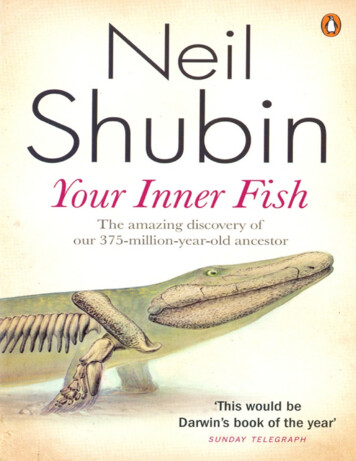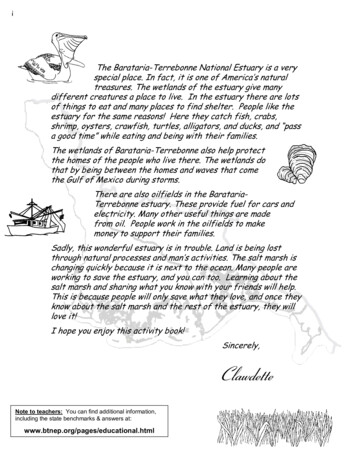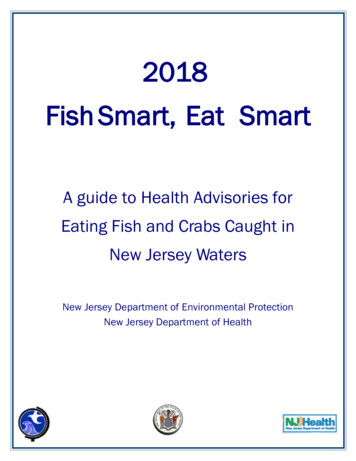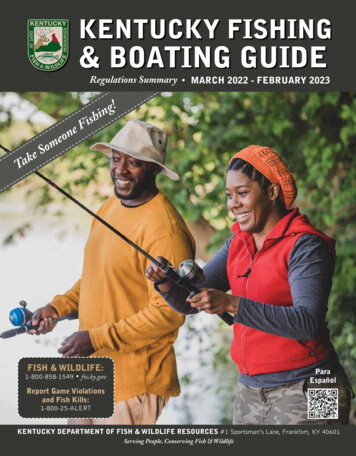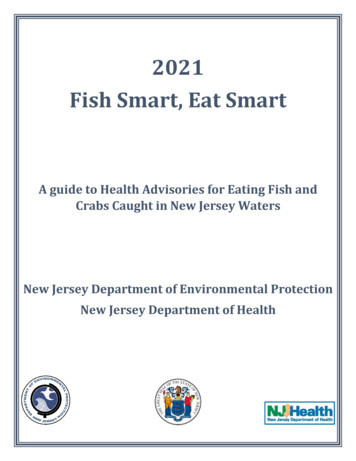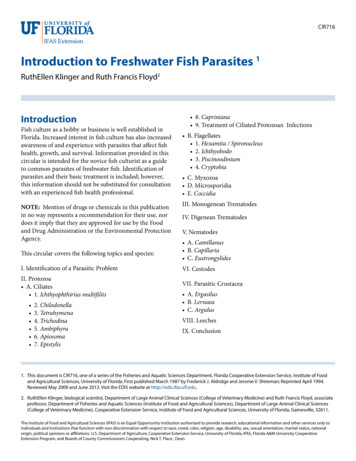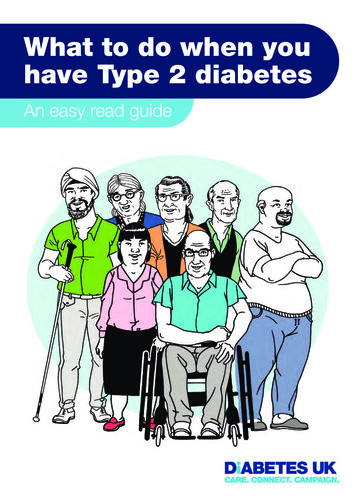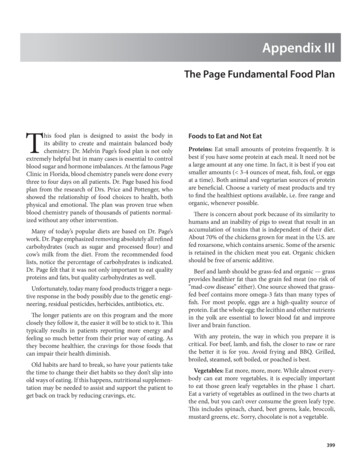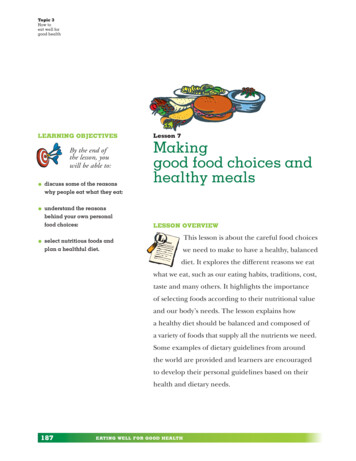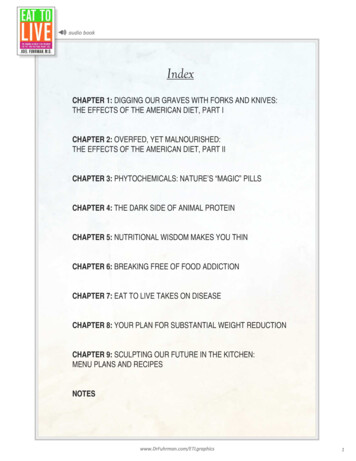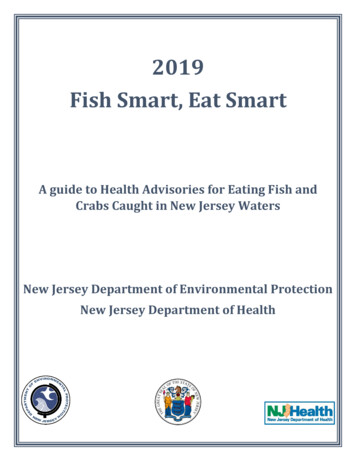
Transcription
2019Fish Smart, Eat SmartA guide to Health Advisories for Eating Fish andCrabs Caught in New Jersey WatersNew Jersey Department of Environmental ProtectionNew Jersey Department of Health
Table of ContentsIntroduction . .3General Consumption Guidelines . 4Health Effects from Consumption of Contaminated Fish and Crabs . .5Preparation and Cooking Methods for Fish and Crabs under Advisory . .7Federal Advice on Fish Consumption . .8Statewide 2019 Fish Consumption Advisory Table . .9Map of New Jersey Advisory Waters . .10Statewide Water Body Locations .11The New Jersey Department of Environmental Protection and the New Jersey Departmentof Health can provide more information on the advisories and the health effects of chemicalcontaminants in the fish. To stay current with advisory updates and to request additionalinformation, please contact the NJDEP, Division of Science and Research at 1-609-984-6070or check the website https://www.FishSmartEatSmartNJ.org or the NJDOH at (609) 8264935.2
IntroductionThis 2019 update uses the results of a study involving the analysis of samples of fish species collected fromlakes, rivers, ponds and reservoirs that flow within the Upper Delaware River and Passaic River regions.This information was used to support the continuation and revision of the current fish consumptionadvisories for this region and identified the need for additional fish consumption advisories.This booklet summarizes the marine, estuarine and freshwater fish consumption advisories for New Jersey.It provides you with information on how to reduce your risk by avoiding or limiting consumption of certainfish. It also offers guidance in how to prepare the fish you eat from local waters in ways that reduce yourexposure to PCBs, dioxins and other contaminants.Fishing provides enjoyable and relaxing recreation. Many people enjoy cooking and eating their own catch.Fish are an excellent source of protein, minerals and vitamins, are low in fat and cholesterol and play animportant role in maintaining a healthy, well-balanced diet. The American Heart Association recommendspeople eat fish regularly. Fish are also one of the few foods that are rich in the omega-3 fatty acids neededfor proper development of the brain and nervous system in the fetus and infants and may reduce the riskof heart attack. Fish are an excellent substitute for other protein foods that are higher in saturated fats andcholesterol. Health professionals recommend that you include fish in your diet.However, certain fish may contain contaminants, such as polychlorinated biphenyls (PCBs), dioxins,mercury, and other contaminants from the water they live in and the food they eat. Contaminants such asdioxin and PCBs are classified by the U.S. Environmental Protection Agency as probable cancer-causingsubstances in humans. Elevated levels of mercury can pose health risks to the human nervous system,particularly to developing fetuses. Therefore, it is a good idea to follow a few precautions in consumingrecreationally caught fish and crabs, particularly if you eat them often.Since 1982, when research began to show elevated levels of potentially harmful contaminants in certainfish and crabs in some New Jersey waters, fish consumption advisories were adopted to guide citizens onsafe consumption practices. Fish consumption advisories are developed through a scientific process thatincludes collecting samples of fish from waters throughout the state and analyzing them for variouschemical contaminants. The contaminant levels in the fish are then evaluated using state and federalguidelines for protecting human health.The New Jersey Department of Environmental Protection (NJDEP) and Department of Health (NJDOH)provide advice on consuming those species of fish in which high levels of chemical contaminants have beenfound. Since levels of contaminants may vary from one location to another and from one fish species toanother, the advisories are also separated by site. So be sure to check which guidelines refer to yourfishing location and the fish species you catch.2019 Fish Consumption Advisories for PCBs, Dioxin and MercuryThe advisory table in this booklet provides statewide, regional, and water body-specific advisoryinformation for various fish species. The table lists the recommended fish consumption frequencies for theGeneral Population and High-risk Individuals for waters statewide and for specific water bodies.3
High Risk Individuals: Includes infants, children, pregnant women, nursing mothers and women ofchildbearing age.General Population: Includes all others not in the high-risk category.All fish consumption advisories are presented in meal frequencies (for example: one meal permonth or four meals per year). For PCB advisories this range is based on an estimated 1 in 10,000 riskof cancer during your lifetime from eating fish at the advisory level. This means that one additional cancermay occur in 10,000 people eating fish at the advisory level for a lifetime.By using this advisory, you have the necessary information to make an informed choice on the number ofmeals of fish to consume. You can reduce your risk further by eating less than the advisory meal frequency,however, this need to be balanced with the health benefits of eating fish.The limits that follow each species assume that no other contaminated fish are being eaten. If you eat morethan one species of fish listed in the advisory, the total consumption of fish should not exceed therecommended frequency as a guideline for consumption. The best approach is to use the lowestrecommended frequency as a guideline for consumption. Example: If you fish Union Lake, and you arein the general population category, you can eat four meals of white perch or you can eat one mealof Largemouth Bass over the course of a month, but not both.If your specific fishing location is not mentioned within the advisories on the following pages, this does notmean the fish are free of contamination. Not all New Jersey waters or fish species have been tested, and notall fish species were found in all locations, or in some cases available data were insufficient to list a speciesfor a specific water body. Follow the statewide advisory for the listed species if your fishing area isnot mentioned in the guidelines or follow the statewide advisory of one meal per week for (generalPopulation) or one meal per month (high-risk individuals) for freshwaters.General Consumption GuidelinesFish Species: Contaminant levels may vary from species to species. If possible, eat smaller amounts ofseveral different types of fish rather than a large amount of one type that may be high in contaminants. Tryto focus your consumption on those species of fish that have lower levels of contaminants, such as fluke orflounder.Fish Size: Smaller fish of a species will usually have lower chemical levels than larger fish in the samelocation because contaminants tend to build up in the fish over time. It is advisable to eat smaller fish (oflegal size) more often than larger fish.High-risk Individuals: Infants, children, pregnant women, nursing mothers and women of childbearingage are considered to be at higher risk from contaminants in fish than members of the general public.People within this category should be particularly careful about following the advisories, because of thegreater potential for PCBs, dioxin and mercury to affect the development of the fetus, infant, and youngchild.Subsistence Fishing: Avoid subsistence level (relying on wild caught fish for daily nutritional needs)fishing activities in large rivers within or immediately downstream of large urban/ industrial areas andwastewater outfalls. Fish in these areas are more likely to contain traces of chemical contaminants.4
Health Effects from Consumption of Contaminated Fish and Crabs (General Advice)Exposure to low levels of some contaminants in the environment may have long lasting health effects onpeople. Mercury, PCBs and dioxins are among the major contaminants found in some New Jersey fish inportions of the state. These contaminants can be especially harmful to women of childbearing age, pregnantwomen and nursing mothers. Trace amounts of these contaminants may remain in your body for a periodof time after eating. Should you become pregnant during this time, these contaminants can be passed alongto your fetus, potentially affecting the development of the nervous system. Children are also at risk ofdevelopmental and neurological problems if exposed to these chemicals.MercuryMercury is a toxic metal that has been commonly used in a number of products (e.g., thermometers,electrical switches). There are many sources of mercury in the environment, natural and man-made;primary sources include burning of fossil fuels such as coal, incineration of wastes, and metal processing/manufacturing.NJ has taken aggressive action to reduce sources of mercury in the state.Levels of mercury from in-state air sources have been reduced by over 90%since the 1990s. Current sources of mercury to NJ are primarily fromglobal as well as other states’ air emissions (e.g., coal power plants) andnatural emissions.Mercury discharged to the environment can end up in local water bodies. Mercury accumulates in fishmuscle tissue through the aquatic food chain from the food that fish eat. Above certain levels, mercury candamage the nervous system, particularly in unborn and young children, resulting in learning anddevelopmental delays. Regular consumption, of even low amounts of mercury may cause subtle effects onthe central nervous system in both children and adults. In addition, long-term consumption of fish withelevated levels of mercury by adults and older children may result in adverse health effects, includingneurological damage. For more information go to: www.epa.gov/mercury.PCBsPCBs Polychlorinated biphenyls (PCBs) were commercially produced for industrial application in heattransfer systems, hydraulic fluids and electrical equipment. They were later incorporated into other usessuch as printing inks, paints and pesticides. The manufacture of PCBs was stopped in 1979 as a result ofevidence that PCBs build up in the environment and cause harmful effects. PCBs tend to stay mostly in soiland sediment but are also found in the air and water.Once they enter the food chain, they have a tendency to absorb into fat tissue. PCBs build up in fish to levelsthat are hundreds of thousands of times higher than the levels in the surrounding water. When peopleconsume fish that have already accumulated PCBs, the PCBs then accumulate in their bodies.PCBs have been shown to cause cancer in animals, and there is evidence that PCBs may cause cancer inexposed humans. PCBs have also been shown to cause a number of serious health effects besides cancer inhumans and animals, including effects on the nervous system of the developing fetus, the immune system,5
and the reproductive system. Studies have shown that unborn and young children are most at risk to PCBexposure. Because PCBs take a long time to leave the body after they accumulate, women who plan tobecome pregnant should follow the more restrictive consumption advice before becoming pregnant. Formore information go to: ed-biphenyls-pcbsDioxinDioxin is the most toxic member of a large chemical family of related dioxins and furans. Dioxin is anunwanted industrial byproduct formed through numerous processes, including production of chlorinatedphenol products such as herbicides, the incineration of municipal solid waste, and creation of paperproducts using bleach. Most of what we know about dioxin has been obtained through animal toxicitytesting in the laboratory and representative wildlife species. Dioxin produces a number of effects in animaltesting, including suppression of the immune system, impaired reproduction, birth defects in some speciestested, a skin condition called chloracne, alterations in liver function, and cancer. The federalEnvironmental Protection Agency (EPA) has classified dioxin as a probable human carcinogen. For moreinformation go to: lfishPFOSPFOS (perfluorooctane sulfonate) is a member of a larger group of chemicals known as PFAS (per- andpolyfluoroalkyl substances). PFOS has been used in a variety of consumer products and industrialapplications including water/stain resistant clothing, and aqueous film-forming foams employed infirefighting primarily at military bases and civilian airports. PFOS that is released into the environment cancontaminate surface water as well as groundwater used as drinking water sources. PFOS that enterssurface waters can accumulate in freshwater fish. Consumption of fish from contaminated waters can leadto exposure to PFOS at levels that may cause health concerns. Studies in human populations exposed toPFOS have identified a number of health effects that are associated with PFOS. The most sensitive of theseeffects involve effects on the immune system, including decreased vaccine response and increasedincidence of childhood infections that are associated with maternal exposure during pregnancy. Studieshave also identified increased serum uric acid/hyperuricemia as well as increased total cholesterol. Animalstudies have also shown that the immune system is very sensitive to PFOS which causes decreasedresponse to foreign substances. In addition, animal studies have also identified effects of PFOS on the liverand thyroid hormones. Developmental effects have also been observed in the offspring of pregnant animalsexposed to PFOS.Because PFOS can cross the placenta, consumption of PFOS contaminated fish by pregnant women andwomen of childbearing age places them in a high-risk population category for fish consumption advisories.The health effects from other PFAS may differ somewhat from those for PFOS, but all have the ability tocross the placenta, and therefore, also place pregnant women and women of childbearing age in the highrisk population category.6
Preparation and Cooking Methods for Fish and Crabs under AdvisoryThe best way to reduce exposure to contaminants in fish is to learn what fish species are affected and eitherlimit or avoid consumption. However, if you must eat those species under advisories, there are steps youcan take to reduce your exposure. Contaminants tend to concentrate in the fatty tissue of the fish you catch.Proper cleaning and cooking techniques, which remove some of the fat from the fish, can significantlyreduce levels of PCBs, dioxins and other organic chemicals. Please note, however, that these techniqueswill not reduce or remove unsafe levels of mercury from these fish. Mercury occurs in the flesh. There isno way to remove mercury through cooking. The best way to reduce mercury exposure is to select thosespecies of fish which are known to have lower levels of mercury.Fish Preparation MethodsProper fish cleaning and cooking techniques may reducePCB levels by approximately 50 percent when compared toraw fish fillets. A meal size is considered to be an uncooked8-ounce fillet. Eat only the fillet portions. Do not eat wholefish or steak portions. Many chemical contaminants, likePCBs and pesticides (but not mercury), are stored in thefatty portions of fish. To reduce the levels of these chemicals,skin the fish and trim any of the dark meat (lateral line),back strap and belly flap. The following diagram illustratesthose body portions. Do not eat the heads, guts or liver, because PCBs usually concentrate in those bodyparts. Also, avoid consumption of any reproductive parts such as eggs (roe).Fish Cooking MethodsUse a cooking method such as baking, broiling, frying, grilling, or steaming that allows the fats and juicesto drain away from the fish. When possible, cook the fish on an elevated rack that allows fats and juices todrain to the pan below. Avoid batter, breading or coatings that can hold in the juices that may containcontaminants. The juices should be thrown away since they contain the PCBs and other chemicals thatwere in the fat. Do not pour these juices over the fish as a sauce or to moisten the fish. Butter, margarineor other liquids can be added to the fish for this purpose once the juices have been poured off. After cooking,discard all liquids and frying oils. Do not reuse. Do not use heads, skin, trimmed fatty portions in soups,stews, chowders, boils, broth or for fish stock. If you make stews or chowders, only use skinless fillet parts.Raw fish may be infested by parasites. Cook fish thoroughly to destroy the parasites. This also helps toreduce the level of many chemical contaminants.Crab Preparation MethodsEating, selling or taking (harvesting) blue crabs from NewarkBay Complex and the tidal Passaic River is prohibited. TheNewark Bay Complex is located in northeastern New Jersey. Itincludes the Newark Bay, tidal Hackensack River, Arthur Kill,Kill Van Kull and tidal tributaries. (See chart on page 6.) If bluecrabs are taken from water bodies other than the Passaic River/7
Newark Bay Complex, the following preparation techniques can be followed to reduce exposure to somecontaminants.The highest levels of chemical contaminants are found in the hepatopancreas, commonly known as thetomalley or green gland. It is the yellowish green gland under the gills. This material is found next to thelump meat (backfin) portion of the crab. Chill and break the crabs immediately before cooking. Care mustbe taken to remove all of the hepatopancreas before cooking.There is no specific cooking method available to reduce the chemical contaminant levels in blue crabs. Thefollowing steps for proper preparation are key to reducing your exposure to harmful chemicalcontaminants.Do not eat the green gland (hepatopancreas). Remove green gland (hepatopancreas) before cooking. Aftercooking, discard the cooking water. Do not use cooking water or green gland (hepatopancreas) in anyjuices, sauces, bisques or soups.See brochures on the FishSmartEatSmartnj.org website for instructions on ways to properly cleanand cook fish and crabs.Crab (English) (Spanish)Carp (English) (Polish)Catfish(English)Federal Advice on Fish Consumption for Pregnant Women and ChildrenThe following is provided as general information and advice from the federal government. Do not eat Shark,Swordfish, King Mackerel, Marlin, Orange Roughy, Bigeye Tuna or Tilefish (Gulf of Mexico) because theycontain high levels of mercury. Note: No advisory for Tilefish harvested from the mid-Atlantic and southernNew England area. See ting-fish for detailedinformation.What Pregnant Women & Parents Should KnowFish and other protein-rich foods have nutrients that can help your child’s growth and development. Forwomen of childbearing age (about 16-49 years old), especially pregnant and breastfeeding women, and forparents and caregivers of young children.Additional information on contaminants in New Jersey’s fish, see fishsmarteatsmart.org.For more information on EPA freshwater fish consumption advisories, go to https://www.epa.gov/fish-tech8
2019 New Jersey Fish Consumption AdvisoriesStatewide Estuarine and Marine Waters(Applies to all coastal waters and includes the water way specific advisories)SpeciesGeneral Population (2,3)High Risk Population (1,2,3)Striped Bass*One meal per monthDo not eatAmerican EelFour meals per yearDo not eatBluefish (greater than 6lbs./Six meals per yearDo not eat24 inches)Bluefish (less than 6 lbs./ 24One meal per monthDo not eatinches)Do not eat the green glandDo not eat the green glandAmerican Lobster(tomalley or hepatopancreas)(tomalley or hepatopancreas)2019 New Jersey Fish Consumption AdvisoriesStatewide Freshwater(Applies to all waters except Pinelands region and includes the waterbody specific advisories)SpeciesGeneral Population (2,3)High Risk Population (1,2,3)Trout (Brown, Brook, Rainbow,One meal per weekOne meal per weekand Hybrid Species)Largemouth BassSmallmouth BassChain PickerelSunfish4Brown BullheadYellow BullheadCommon CarpOne meal per weekOne meal per weekOne meal per weekNo restrictionsNo restrictionsNo restrictionsOne meal per monthOne meal per monthOne meal per monthOne meal per monthOne meal per weekOne meal per monthOne meal per monthDo not eat2019 New Jersey Fish Consumption AdvisoriesPinelands Region1High-Risk(Applies to all Pinelands waters including the waterbody specific advisories)SpeciesGeneral Population (2,3)High Risk Population (1,2,3)Largemouth BassOne meal per monthDo not eatSmallmouth BassOne meal per weekOne meal per monthChain PickerelOne meal per monthDo not eatSunfish4No restrictionsOne meal per monthBrown BullheadOne meal per weekDo not eatYellow BullheadOne meal per weekDo not eatCommon CarpOne meal per weekOne meal per monthIndividuals include infants, children, pregnant women, nursing mothers and women of childbearing age.meal is defined as an eight-ounce serving.3Eat only the fillet portions of the fish. Use proper trimming techniques to remove fat, and cooking methods that allow juices to drainfrom the fish (e.g., baking, broiling, frying, grilling, and steaming). See text for full description.4Sunfish includes bluegill, pumpkinseed, and redbreast sunfish species.5No harvest means no taking or attempting to take any blue crabs from these waters.6Do not eat the hepatopancreas, discard cooking liquid*Selling these species for human consumption from designated New Jersey waters is prohibited.Note: Not all fish species available were collected and/or analyzed from all waterways.2One9
For specific site locations, please see our online story map10
Freshwater Waterbody Specific AdvisoriesAtlantic CountyCape May CountyAtlantic City Reservoir at PomonaGreat Egg HarborLenape Lake at Mays LandingMaple Lake at Estell ManorMullica River-Green Bank to BatstoLakeRiverLakeLakeRiverLake Tappan at Old TappanOradell ReservoirOverpeck Creek at Ridgefield ParkPassaic River-Elmwood Park to DundeeLake at GarfieldLakeLakeLakeBergen CountyEast Creek Pond at EldoraLake Nummy at WoodbineCumberland CountyRiverAtsion LakeBatsto LakeCrosswicks Creek at BordentownCrystal Lake at FieldsboroHarrisville PondLake AbsegamiLake Oswego at Jenkins NeckLittle Pine Lake at Browns MillsMirror Lake at Browns MillsRancocas Creek at DelranRancocas Creek at RiversideStrawbridge Lake at MoorestownWading RiverWhitesbog PondCamden CountyBig Timber Creek West Deptford atRunnemedeClementon LakeCooper River Park Lake at CollingswoodCooper River at Hopkins PondCooper River at Evans PondEvans Pond at HaddonfieldKirkwood Lake at LindenwoldLinden Lake at LindenwoldLittle Timber Creek at BrooklawnNew Brooklyn Lake at SickervilleNewton Lake-NorthNewton Lake-SouthNewton Creek at CollingswoodPennsauken Creek at Forked Landing RoadCedar Lake at CedarvilleCedarville PondsCohansey River at BridgetonMenantico Sand Pools at MillvilleStow Creek at CantonSunset LakeMaurice River- Downstream of MillvilleUnion Lake at MillvilleLakeLakeRiverLakeLakeLakeRiverLakeBranch Brook Park Lake at NewarkPassaic River- Route 280 at confluence ofPompton River at Two BridgesWeequahic Park Lake at NewarkLakeAlcyon Lake at GlassboroMalaga Lake at FranklinMantua Creek at PaulsboroMarlton LakeOldmans Creek at Route 130 BridgeRaccoon Creek at BridgeportStewart Lake at WoodburyWilson Lake at Fries MillsWoodbury re River at Phillipsburg/EastonDelaware River at Phillipsburg to TrentonDelaware River at LambertvilleLamington River at LamingtonRiverRiverRiverRiverEssex CountyBurlington verLakeRiverLakeGloucester CountyHunterdon LakeLakeRiverRiverRaritan River- South Branch at Long Valley(Clairmont Section)Raritan River- South Branch at High BridgeRaritan River- South Branch at FlemingtonRound Valley Reservoir at LebanonSpruce Run Reservoir at Clinton11LakeLakeRiverLakeRiverRiverRoverLakeLake
Mercer CountyOcean CountyAssunpink Creek at WindsorCarnegie Lake at PrincetonD&R Canal at West TrentonD&R Canal at Port MercerDelaware River- Phillipsburg to TrentonDelaware River at TrentonGrovers Mill Pond at Princeton JunctionLake Mercer at EdinburgPeddie Lake at HightstownRosedale Lake at LakeDavidson’s Mill Pond at DeansD&R Canal at GriggstownDeVeo Lake at SpotswoodDuhernal Lake at SpotswoodFarrington Lake at MilltownManalapan Lake at JamesburgWeston Mill Pond at New BrunswickLakeRiverLakeLakeLakeLakeLakeAssunpink Creek at WindsorAssunpink Lake at RooseveltDeal Lake at Asbury ParkLefferts Lake at MatawanManasquan Reservoir at Howell TownshipMarlu Lake at Thompson County ParkMetedeconk River-North Branch at SiloamMetedeconk River at Forge PondShadow Lake at Red BankSpring LakeSwimming River Reservoir at LincroftWampum eLakeBudd LakeJersey City Reservoir at BoontonLake Hopatcong-Entire LakeLake Hopatcong at WoodportOak Ridge ReservoirLakeLakeLakeLakeLakeMiddlesex CountyMonmouth CountyMorris CountyPassaic River-Rt. 280 to confluence of PomptonRiver at Two BridgesPompton River at Lincoln ParkRamapo River at Pompton/Wayne (Pompton Feeder)Rockaway River at PowervilleRockaway River at WhippanySpeedwell Lake at MorristownSplitrock Reservoir at keLakeRiverLakeClinton Reservoir at West MilfordEcho Lake Reservoir at West MilfordGreen Turtle Lake at HewittGreenwood Lake at West MilfordMonksville Reservoir at RingwoodOak Ridge ReservoirPassaic River- Route 280 to confluence ofPompton River at Two BridgesPassaic River-Elmwood Park to DundeeLake at GarfieldPompton LakePompton River at Lincoln ParkRamapo Lake at WanaqueSheppard Pond at RingwoodWanaque ReservoirLakeLakeLakeLakeLakeLakeDOD Lake at Penns GroveFenwick Creek at Mannington MillsMaskells Mill Lake at CantonOldmans Creek at Route 130 BridgeParvin Lake at PittsgroveSalem River at Salem River WMAWillow Grove Lake at MalagaWoodstown Memorial LakeLakeRiverLakeRiverLakeRiverLakeLakePassaic CountySalem CountyRiverRiverRiverRiverRiverLakeLakeButterfly Bogs Pond at VanhisevilleDouble Trouble LakeEnno Lake at Bennetts MillsHoricon Lake at LakehurstLake Carasaljo at LakewoodLake ManahawkinPine Lake at LakehurstPohatcong Lake at TuckertonProspertown LakeShenandoah Lake at LakewoodStafford Forge Main LineSuccess Lake at Colliers MillToms River at Ridgeway BranchTurn Mill Pond at Colliers Mill12RiverRiverLakeRiverRiverLakeLake
Somerset CountyBound Brook-Entire LakeBound Brook at New Market Pond at SouthPlainfieldD&R Canal at GriggstownD&R Canal at Bound BrookGreen Brook at Madison Ave BridgeLamington RiverMillstone River at ManvilleRaritan River-North Branch at BranchburgRaritan River-South Branch at Neshanic StationRaritan River- Confluence of the MillstoneRiver at MillstoneLakeBlue Mountain Lake at Five PointsCanistear Reservoir at StockholmCatfish Pond at HardwickCranberry Lake at ByramCrater Lake at Five PointsDelaware River-NY Borderline to Water GapDelaware River at Milford/MontagueHainesville PondLake Aeroflex at AndoverLake Hopatcong-Entire LakeLake Hopatcong at WoodportLake Musconetcong at StanhopePaulinskill Lake at NewtonSaw Mill Pond at ColesvilleSteeny Kill Lake at ColesvilleSwartswood LakeLittle Swartswood LakeWawayanda Lake at Highland eLakeLakeLakeLakeLakeLakeLakeRahway River at Milton LakeRahway River at Valley Road PondRiverRiverAllamuchy PondColumbia LakeDelaware Lake at ColumbiaDelaware River-NY Borderline to Water GapDelaware River-Delaware Water Gap toPhillipsburgFurnace Lake at OxfordMerrill Creek Reservoir at StewartsvilleMountain Lake at ButtzvilleWhite Lake at erRiverRiverRiverRiverRiverSussex CountyUnion CountyWarren CountyLakeLakeLakeLake13
ESTUARINE & MARINE WATERBODY SPECIFICADVISORIES(Please follow this link to our statewide advisories for other species as well)Newark Bay ComplexIncluding Newark Bay, Tidal Hackensack River, Arthur Kill, Kill Van Kull, and all tidaltributariesNew- New ngedPopulation(2,3)Population(1,2,3)Updated-New data, noBlue Crab*Striped Bass*White PerchWhite CatfishAmerican EelAtlantic NeedlefishRainbow SmeltGizzard ShadBluefishDo not harvest or eat5Do not harvest or eat5Four meals per yearOne meal per monthDo not eatDo not eatDo not eatDo not eatDo not eatDo not eatDo not eatDo not eatSummer FlounderOne meal per monthDo not eatBlue Crab*Do not harvest or eat5Do not eatFour meals per yearOne meal per yearFour meals per yearOne meal per monthOne meal per monthDo not eatchange in 19 (NY Advisory)New-2019 (NY Advisory)New-2019 (NY Advisory)New-2019New-2019Passaic River (Tidal)From the head of tide at Garfield to Newark Bay and all tidal tributariesNew- New advisorySpeciesGeneralHigh-RiskRevised-Advisory changed(2,3)(1,2,3)PopulationPopulationUpdated-New data, noAll finfish & shellfish*Do not harvest or eat5Do not eatchange in advisoryUpdated-2019Hudson RiverFrom the NY-NJ borderline (near Alpine, NJ) downstream of the NY-NJ borderline on theUpper New York Bay (at Bayonne, NJ)New- New ngedPopulation (2,3)Population(1,2,3)Updated-New data, noBass*StripedWhite PerchWhite CatfishAmerican Eel*Blue CrabFour meals per yearOne meal per yearDo not eatOne meal per yearDo not eatDo not eatDo not eatDo not eatOne meal of 7 crabsper week (do not eatthe green gland)6One meal of 7 crabs
important role in maintaining a healthy, well-balanced diet. The American Heart Association recommends people eat fish regularly. Fish are also one of the few foods that are rich in the omega-3 fatty acids needed for proper development of the brain and nervous system in the fetus and infants and may reduce the risk of heart attack.
